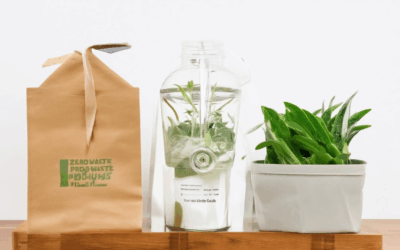Creating a sustainable and eco-friendly meal plan has never been more essential in today’s increasingly conscious world. With the rise of climate awareness and the push toward healthier lifestyles, many individuals are seeking ways to reduce their environmental footprint while maintaining nutritious and delicious meals. This guide delves into the intricacies of crafting a meal plan that aligns with both personal health goals and planetary well-being. From understanding the 3-2-1 meal plan to exploring the best eco-friendly meal kits, we’ll walk you through strategies to minimize waste, reduce your carbon footprint, and enjoy meals that are as good for the earth as they are for your body. Whether you’re new to sustainable living or looking to refine your existing habits, this comprehensive approach offers practical tips and insights to help you make informed decisions that benefit both you and the environment.
Key Takeaways
– Adopt a low-waste diet by reducing food waste, composting scraps, buying local, and shopping in bulk for zero-waste living.
– Choose sustainable protein sources, including plant-based options like beans and tofu, along with ethically sourced meats, to minimize environmental impact.
– Embrace a minimalist diet focused on whole, nutrient-dense foods like fruits, vegetables, and whole grains to reduce packaging and resource use.
– Practice mindful eating by controlling portion sizes, using seasonal ingredients, and storing leftovers in reusable containers.
– Reduce packaging impact by purchasing in bulk, using reusable bags, and supporting eco-friendly brands to minimize single-use plastics.
– Prioritize sustainable foods such as leafy greens, fruits, legumes, whole grains, plant-based proteins, and local produce for a nutritious and environmentally friendly diet.

What is the 3-2-1 Meal Plan?
The 3-2-1 meal plan is a flexible dietary approach designed to simplify meal planning while promoting balanced nutrition. It involves selecting three types of meals and two protein shake options, along with one snack, based on your daily caloric needs.
How It Works
- Three 100-calorie Snacks: These are small, nutrient-dense treats that help control hunger between main meals and support overall health.
- Two Protein Shakes: These are typically low-calorie, high-protein beverages that aid in muscle repair and recovery.
- One 500-calorie Main Meal: This is a more substantial meal that provides a good balance of macronutrients.
This plan allows individuals to customize their intake according to their energy needs, making it ideal for those looking to manage weight, build muscle, or maintain a healthy lifestyle. By focusing on portion control and balanced nutrition, the 3-2-1 method helps reduce food waste and simplifies meal preparation.
Benefits
- Convenience: Simplified meal planning reduces decision fatigue and saves time.
- Flexibility: Adjusts easily to accommodate various dietary preferences and restrictions.
- Nutritional Balance: Promotes consistent energy levels and long-term health.
Sample Meal Plan
Example for a 1200-calorie day:
- Snacks: Apple slices with peanut butter (100 calories), Greek yogurt with berries (100 calories), and baby carrots with hummus (50 calories)
- Protein Shakes: Two shakes totaling around 400 calories (e.g., whey protein powder mixed with almond milk)
- Main Meal: Grilled chicken breast, quinoa, and steamed broccoli (totaling approximately 500 calories)
Customization Tips
- Adjust portion sizes based on individual goals.
- Experiment with different proteins, grains, and vegetables.
- Stay hydrated with water, herbal teas, or electrolyte drinks.
Eco Planeta Verde encourages individuals to explore this meal plan as part of a holistic approach to wellness. By prioritizing whole foods and mindful eating, participants can achieve their nutritional objectives while supporting sustainable living practices.
What is the Most Eco-Friendly Meal Kit?
Eco-friendly meal kits are becoming increasingly popular as consumers seek to reduce their environmental impact while enjoying delicious meals. Among the many options available, several stand out for their commitment to sustainability. Here’s a breakdown of some of the most eco-friendly meal kits:
- Green Chef – Best Overall Eco-Friendly Meal Kits Green Chef offers a variety of organic, sustainably sourced, and thoughtfully crafted meal kits. Their ingredients are carefully selected to minimize their carbon footprint, and they provide recipes that maximize nutrient density while reducing food waste.
- Purple Carrot – Plant-Based Options Purple Carrot is a leader in plant-based meal kits, offering vegan and vegetarian options made with locally-sourced ingredients whenever possible. Their packaging is 100% compostable, and they focus on reducing waste through innovative packaging solutions.
- Fresh Del Monte – Local and Seasonal Ingredients Fresh Del Monte emphasizes the use of locally-grown and seasonal ingredients, which reduces transportation emissions and supports regional farmers. Their meal kits are designed to minimize waste and feature recipes that highlight the freshest ingredients available.
- Marley Spoon – Organic and Sustainable Practices Marley Spoon provides organic and sustainably sourced meal kits that cater to various dietary preferences. They work closely with suppliers to ensure fair labor practices and minimize their environmental impact through responsible sourcing and packaging.
When evaluating eco-friendly meal kits, consider factors like:
- Sustainable ingredient sourcing
- Carbon footprint reduction efforts
- Recyclable and compostable packaging
- Certifications (e.g., USDA Organic, Fair Trade)
Remember to choose a meal kit service that aligns with your values and supports ethical practices. By opting for eco-friendly options, you contribute to a healthier planet while enjoying the convenience of meal kits delivered straight to your door.
For more tips on sustainable living and eco-friendly practices, visit Eco Planeta Verde .

What are the 5 rules in planning meals?
- Plan ahead by scheduling your meals and snacks according to your schedule and preferences.
- Consider dietary needs and preferences to ensure all meals are enjoyable and nutritious for everyone involved.
- Balance nutrition by incorporating a variety of foods from all major food groups to ensure a healthy diet.
- Shop smartly by planning a shopping list based on your meal plan and sticking to it to reduce impulse buying.
- Avoid food waste by measuring portions carefully and using leftover ingredients creatively.
Eco Planeta Verde encourages mindful and sustainable meal planning to minimize waste and maximize nutritional benefits. For more tips and resources, visit our main website .

What is the Most Eco-Friendly Diet?
The most eco-friendly diet focuses on minimizing its environmental footprint while providing nutritious meals. Here’s a breakdown of key components and strategies to create a sustainable diet:
1. Low-Waste Eating
- Reduce food waste by planning meals carefully and storing ingredients properly.
- Compost scraps or donate leftover food to local shelters or community gardens.
- Choose locally-sourced and seasonal produce to minimize transportation emissions.
- Opt for bulk purchasing to reduce packaging waste.
2. Sustainable Protein Sources
- Incorporate plant-based proteins like beans, lentils, tofu, and nuts, which require fewer resources to produce.
- Choose cage-free eggs, free-range poultry, and grass-fed meats when available, though these are less sustainable than plant-based options.
- Limit consumption of fish due to its high environmental impact depending on species and farming methods.
3. Minimalist Diet
- Reduce reliance on processed foods and sugary snacks to minimize packaging and resource use.
- Focus on whole, nutrient-dense foods like fruits, vegetables, whole grains, and legumes.
- Avoid overconsumption of meat and dairy to decrease agricultural intensity.
4. Mindful Eating Practices
- Practice portion control to prevent food waste and reduce the need for excessive packaging.
- Meal plan based on seasonal availability to support local farmers and reduce carbon footprint.
- Use reusable containers for leftovers and invest in eco-friendly kitchenware.
5. Reducing Packaging Impact
- Purchase goods in bulk to reduce plastic wrapping.
- Bring reusable bags and containers to stores to minimize single-use packaging.
- Support brands that use recyclable or biodegradable packaging.
Learn more about sustainable living practices .
By adopting these strategies, individuals can significantly reduce their dietary footprint while enjoying delicious and nutritious meals. For further insights and recipes, visit our sustainable cooking guide .
What is the Most Environmentally Friendly Food?
Eating sustainably can significantly reduce your carbon footprint while promoting healthier dietary choices. Among various options, certain foods stand out for their minimal environmental impact and nutritional benefits. Here are some of the most sustainable foods:
- Leafy Greens : Vegetables like spinach, kale, and lettuce require minimal resources to grow and have a high nutrient density. They contribute less to greenhouse gases compared to meat-based diets.
- Fruits : Fruits are naturally low in calories and rich in vitamins. They are often organic and require less water to grow compared to other crops. Examples include bananas, apples, and berries.
- Legumes : Lentils, chickpeas, and black beans are protein-rich, require little water, and have a lower carbon footprint than animal proteins. They are also versatile in cooking.
- Whole Grains : Whole grains like quinoa, brown rice, and oats are nutrient-dense and have a lower environmental cost than refined grains. They also promote longer satiety.
- Plant-Based Proteins : Foods like tofu, tempeh, and seitan are sustainable alternatives to meat. They use fewer resources and emit less methane gas.
- Local and Organic Produce : Purchasing locally grown and organic produce reduces transportation emissions and exposure to synthetic pesticides. It supports local farmers and ensures higher nutrient content.
Why These Foods Are Better Choices
Sustainable foods not only benefit the environment but also support healthier lifestyles. By incorporating these into your diet, you can reduce your dietary footprint while enjoying delicious and nutritious meals. Consider visiting our website for more tips on sustainable living and recipes featuring these foods.

The Most Sustaining Food
Eating sustainably is essential for protecting the environment and ensuring long-term food security. Among the many options, certain foods stand out for their low environmental impact and nutritional value. Here are some of the most sustainable foods:
- Lentils: High in protein and fiber, lentils require minimal water and resources to grow.
- Black Beans: A great source of plant-based protein, they have a small carbon footprint and are drought-resistant.
- Chickpeas: Known for their versatility and nutrient-rich profile, chickpeas are highly sustainable.
- Sweet Potatoes: Efficient in water usage and packed with vitamins, they are a nutritious choice.
- Spinach: Grows quickly in various climates and is rich in iron and antioxidants.
- Oats: Used in a variety of recipes, oats are sustainable and versatile.
- Corn: A staple in many diets, corn grows well in diverse conditions and provides essential nutrients.
- Quinoa: A complete protein source, quinoa requires little water and grows in poor soil.
- Almonds: While they require more resources, almonds are a healthy option and can be part of a sustainable diet when consumed moderately.
These foods are chosen for their ability to thrive with minimal resources, low water consumption, and reduced carbon emissions. By incorporating them into your meals, you can contribute to a healthier planet while enjoying delicious and nutritious dishes.
Eco Planeta Verde encourages everyone to explore these sustainable food options and learn more about creating a balanced and eco-friendly diet. For further reading, check out our guide to sustainable eating habits .
Conclusion
Sustainable eating is not just about health—it’s about the planet too. By choosing foods like lentils, black beans, sweet potatoes, and others listed above, we can make a positive impact on the environment while still enjoying flavorful and nutritious meals. Remember to reduce food waste, opt for seasonal ingredients, and support local farmers to further enhance the sustainability of your diet.




0 Comments